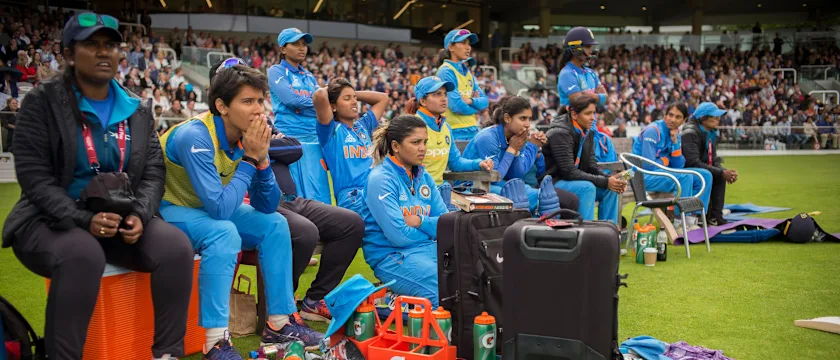Dream over, it’s back to the drawing board for India

After the tears had dried, Veda Krishnamurthy walked to the centre of the Lord’s Cricket Ground for a one-on-one chat with the pitch. She visualised her shots from a few hours back, the ones that had put India on the doorstep of a historic win over England in the ICC Women’s World Cup 2017 final on Sunday.
Mithali Raj and Jhulan Goswami, in their last World Cups, tried hard to not break down while interacting with the media. The visitor’s dressing room wore a forlorn look even as the victory song blared out of the England corner.
It was supposed to be the day that changed the profile of women’s cricket in India. Things were slowly building up after the win over England on the opening day of the tournament, and Harmanpreet Kaur’s unbeaten 171 in the semi-final against Australia had only whetted the appetite. Social media was buzzing with anticipation, with people saying how invested they were now in a ‘new team’.
India, however, fell nine runs short of shedding the burden. It has to now wait for another four years. It is important for the team to feel the hurt and for the Board of Control for Cricket in India to take lessons from the defeat. Having fumbled in a chase in front of 25,000 people, the youngsters will remember the experience the next time they find themselves in a similar situation.
Never has 229 been chased in a Women’s World Cup Final, and India’s lower middle-order lacked adequate batting time in the lead up. Once Harmanpreet and then Poonam Raut got out, it was always going to boil down to which player seized the pressure moments when the game turned on its head. Veda threatened with her 34-ball 35, but Anya Shrubsole took the honours with 6 for 46. Her last five wickets came for just 11 runs in 19 devastating balls, as India was dismissed for 219 in 48.4 overs.
Shrubsole bowled fast, but India’s biggest enemy was pressure. Shikha Pandey’s dismissal after she hit to point and ran for a non-existent single symbolised that after India was 191 for 3.
“We were still in the game until Shikha’s wicket fell. She was the last person I thought could pull that match through,” said Raj afterwards. “When she got out, we needed 11 runs. After that I thought we may not get those 10 runs to equal the total.
“I think the lower middle-order needs to contribute at some point. That is something that has been a concern for the Indian team,” she added. “When it comes to these situations, they don’t really contribute much. It’s important now. It’s like the fielding department; batting is something everybody needs to do no matter which position they go.
“It’s a learning experience for all the girls, and I am sure they will use this experience when they are in a similar situation in the future. But the way they have fought all along the tournament is heart-warming. The India women’s team has a very bright future in the coming years. It’s just a matter of thinking about calculations and keeping your cool in the middle.”
The lower-order batters had extensive batting sessions at the pre-tournament camp in Mumbai, but that is different from being put in real match situations.
Pandey scored two half-centuries from No. 4 in her first four matches in 2014, but since then she has batted at that position only twice in 16 innings. In fact, she has had just two proper hits in the middle since January last year.
England’s lower middle-order was the most consistent through the tournament, and that Katherine Brunt, Jenny Gunn and Laura Marsh took the responsibility to take the team to 228 for 7 after Natalie Sciver fell in the 38th over was not surprising, as they had played similar roles in the league games.
On to back-room matters, Tushar Arothe replacing Purnima Rau as coach a few months before the ICC Women’s World Cup 2017 had initially raised eyebrows, but Raj defended the decision.
“He has worked hard with the girls. He has got a different approach. Since he has played in England, he has been very helpful to the bowlers as well as batters,” pointed out Raj. “I don’t see why I should not be happy about the fact that he has been the coach. He has been positive. The whole support staff as been very positive, looking after the girls.”
Equally, credit should go to the previous and current selectors, who worked towards forming a core group after the first-round exit in the ICC Women’s World Cup 2013 at home. The board, too, showed alacrity by appointing Biju George as fielding coach and Rashmi Pawar as sports therapist to share the workload. That initiative must be sustained.
“Domestic cricket’s structure should get better,” said Goswami. “There should be more matches at Under-16 and Under-19 level, and there should be India ‘A’ tours for exposure because you will find the replacement from there and the bench strength will be prepared.
“We will go home and sit with officials and plan out for the next World Cup, which is in 2021 in New Zealand. If you follow the right process then you will get the right result. The key is to get the bench strength in place. Because of railways not many other teams get competitive matches. That’s a factor, but in a semifinal, Harmanpreet performed. Against New Zealand, Mithali, Veda and Raja (Rajeshwari Gayakwad) performed. There are individual talents, but if we groom the youngsters better then definitely we can sort out things in the future.”